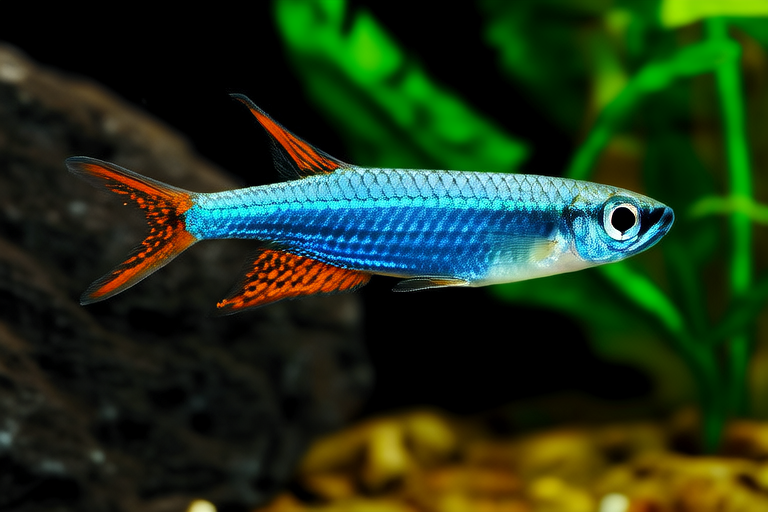From Beginner to Pro: Expert Tips on Raising a Thriving Rajah Cichlid
Introduction to Rajah Cichlids
The Rajah Cichlid, scientifically known as Aequidens rivulatus, is a captivating freshwater fish native to South America. Originating from the rivers of Guyana, Brazil, and Venezuela, these cichlids are distinguished by their vibrant colors and robust personalities. Rajah cichlids are often sought after by aquarists for their striking appearance, which includes a blend of blue, green, and yellow hues. Their active nature makes them a favorite among enthusiasts who enjoy watching dynamic aquatic life. Understanding the unique characteristics and requirements of Rajah cichlids is crucial for any aspiring aquarist.
Ideal Tank Setup
Creating the perfect environment for your Rajah cichlid is essential for its well-being and longevity. The recommended tank size for a single Rajah cichlid is at least 55 gallons, but for a community tank, a larger space of around 75 gallons or more is advisable. This ample space allows the fish to swim freely and reduces stress. The tank should be equipped with a robust filtration system to maintain water quality and oxygen levels. A gentle water current can be beneficial, mimicking the natural river environment. Decorations like caves, driftwood, and rocks provide hiding spots and territorial boundaries. Live plants such as Amazon swords and Java ferns not only enhance the aesthetic appeal but also contribute to a healthier ecosystem.
Water Parameters
Maintaining optimal water conditions is critical for the health of your Rajah cichlids. The pH level should ideally range between 6.0 and 7.5, reflecting the slightly acidic to neutral conditions of their natural habitat. Hardness should be kept within 5 to 15 dGH, and temperature should be maintained between 74°F and 82°F (23°C to 28°C). Regular testing and partial water changes (about 20% weekly) are necessary to ensure stability. Using a reliable water conditioner and maintaining consistent parameters will prevent stress and promote disease resistance.
Diet and Nutrition
Rajah cichlids are omnivorous and require a balanced diet to thrive. In the wild, they feed on insects, small crustaceans, and plant matter. In captivity, a diet consisting of high-quality flake food, pellets, and occasional live or frozen foods like brine shrimp and bloodworms is ideal. Supplementing their diet with vegetables such as zucchini and spinach can help meet their nutritional needs. Feeding should be done in small portions twice daily to prevent overeating and water pollution. It’s important to rotate their diet to ensure they receive all necessary nutrients, promoting healthy growth and vibrant coloration.
Common Health Issues
Like any aquatic pet, Rajah cichlids can be susceptible to various health issues. One of the most common problems is ich, a parasitic infection that manifests as white spots on the fish’s body. Another frequent issue is fin rot, characterized by frayed or disintegrating fins. Maintaining pristine water conditions and a stress-free environment is key to preventing these ailments. Regular observation and early intervention are crucial. If signs of illness are noticed, consulting with a veterinarian specializing in aquatic animals can provide targeted treatment options.
Breeding Tips
Breeding Rajah cichlids can be both rewarding and challenging. Establishing a breeding pair requires patience and careful selection of compatible individuals. Once a pair has formed, providing a spacious tank with ample hiding spots and a suitable spawning site, such as a flat stone or slate, is essential. The female typically lays several hundred eggs, which are then fertilized by the male. Both parents exhibit parental care, guarding the eggs and fry. Ensuring the safety of the offspring involves removing the adult fish once the fry become free-swimming, to prevent predation. Providing live food and a nutritious diet supports the growth of the young cichlids.
Behavioral Insights
Rajah cichlids are known for their bold and sometimes aggressive behavior. They are highly territorial and may display dominant behaviors, especially during feeding times. Introducing new fish into the tank should be done gradually to avoid conflicts. Observing their interactions can provide valuable insights into their social dynamics. Establishing a routine that includes regular feeding and tank maintenance helps reduce stress and promotes a harmonious environment. Understanding their natural behaviors aids in creating a balanced and thriving aquarium.
Transitioning from Beginner to Expert Care
Moving from a novice to an expert in Rajah cichlid care involves continuous learning and adaptation. Joining local aquarium clubs or online forums can provide invaluable support and knowledge sharing. Attending workshops and seminars offered by experienced aquarists can offer hands-on guidance and expert advice. Keeping detailed logs of tank conditions, fish behavior, and health checks can help identify patterns and improve care strategies. As expertise grows, experimenting with different setups and dietary variations can lead to a deeper understanding of these fascinating creatures. The journey from beginner to expert is marked by dedication, patience, and a passion for creating a vibrant and healthy aquatic environment.
In conclusion, raising a thriving Rajah cichlid requires a combination of knowledge, attention to detail, and a genuine love for these magnificent fish. By following the guidelines provided in this article, you can ensure that your Rajah cichlids lead healthy and fulfilling lives. Remember, the key to successful care lies in understanding their unique needs and adapting your approach accordingly.
